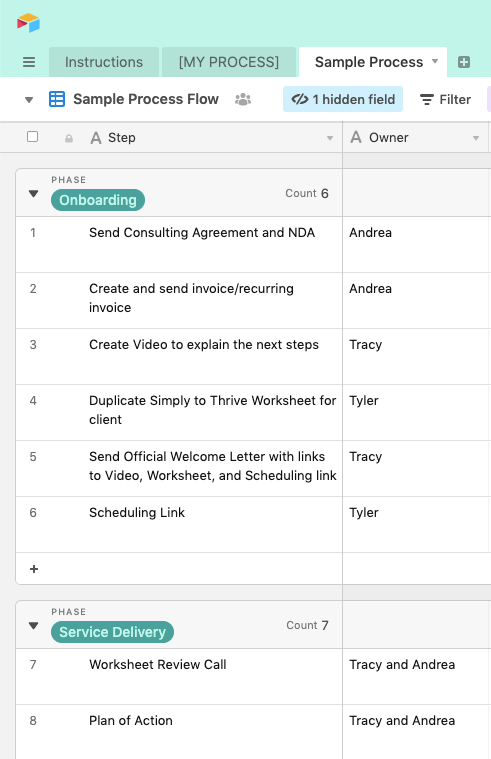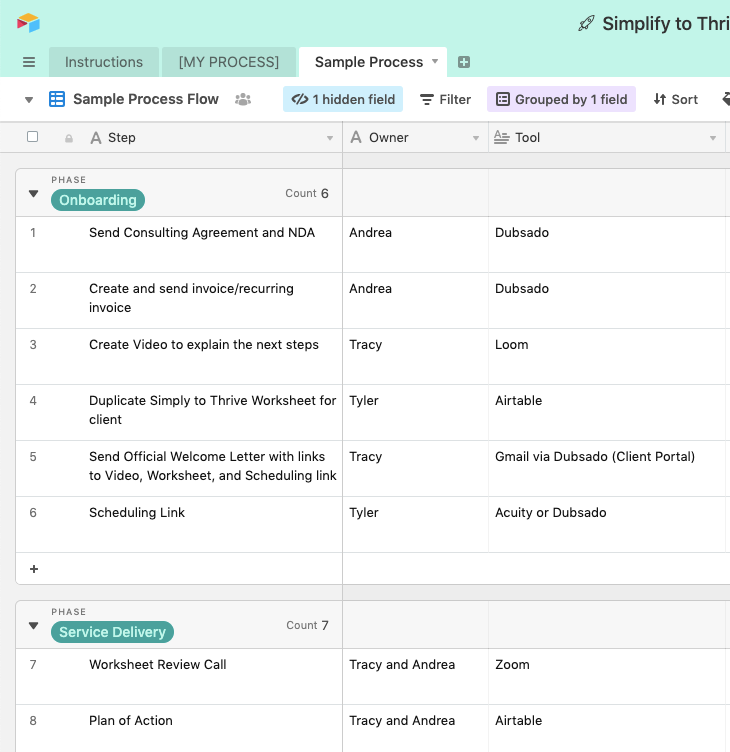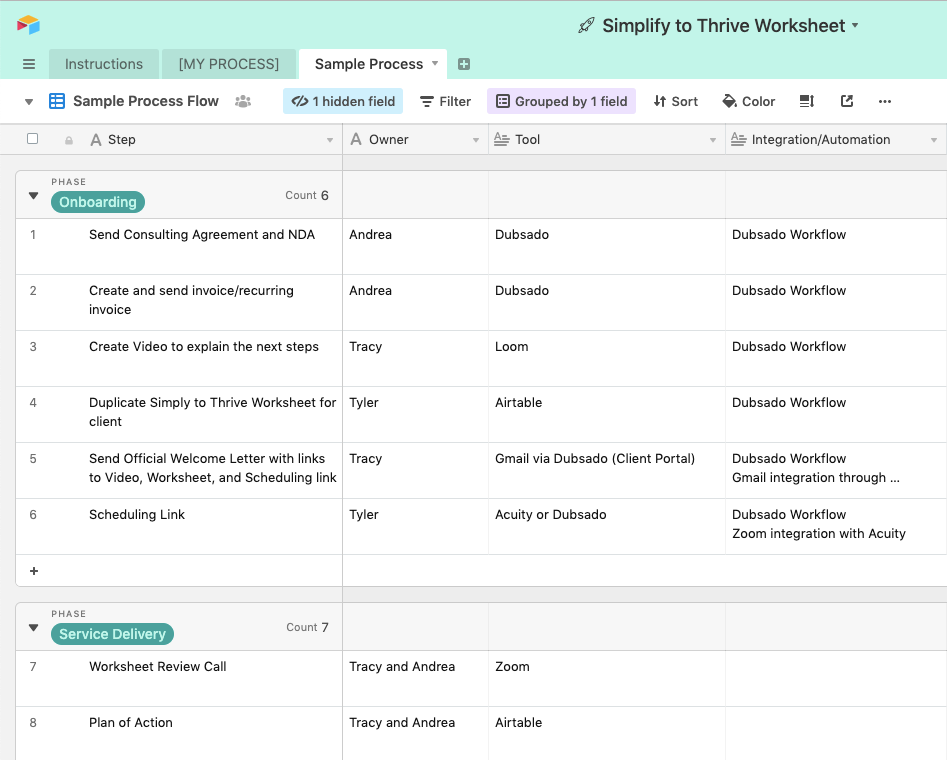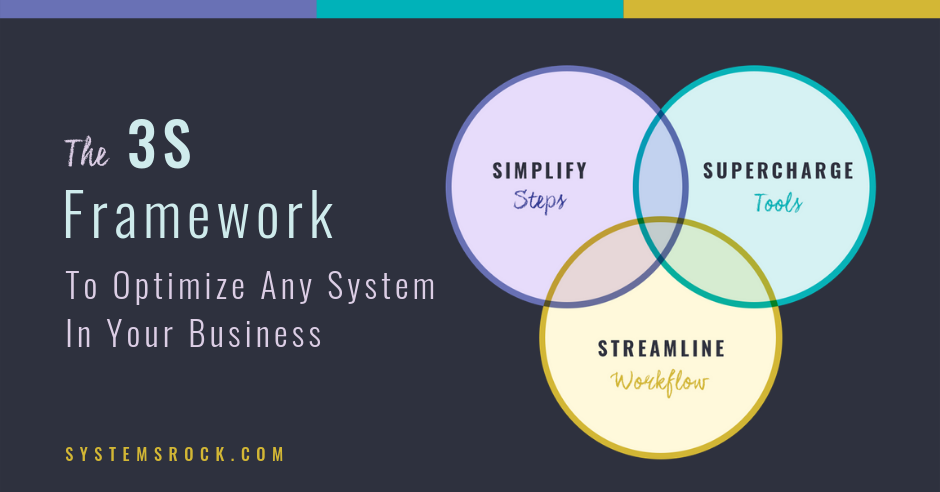Growing a business is not a matter of time or hustle. It’s a matter of design. So, if you are dealing with the level of complexity in your business that wastes a lot of your and your team’s time, you are not stuck with it. You can always re-design things. And for that, you don’t have to put your entire business on hold!
Let me share with you a framework, that will allow you to do just that. It’s the very framework we use when a client asks us for help with system optimization.
Say you want to make your client management process more efficient, effective, and able to accommodate a larger number of clients without adding more team members.
Here’s what you do:
I. Simplify your Steps
Pick an offering and list the steps of the process from when the client says yes to working with you until you offboard them.
If you hate writing the steps on a piece of paper or in a document, get a bunch of post-its and write each step on an individual post-it note.
Arrange the steps in the order of how they happen. For example:

Bonus points: jot down the name of the team member responsible for this step.
Then look critically at the flow. What steps could you improve so your clients receive an even better and more consistent experience? What problems seem to reappear every single time? Are there any steps that you want to add? Are there any steps that don’t really add much value and could be removed? Do you need to change the ownership of any tasks to make your team members happier and more efficient?

When one of our clients, Becky, outlined the steps of her client onboarding and client management process, she immediately saw the places where her workflow could be improved, for example:
- Some of her clients were not being asked to fill out the entry questionnaire because of Becky’s level of familiarity.
We all get these amazing referrals and ideal fit leads that we hesitate to ask all the questions because we feel we know exactly how to help them. However, Becky realized that because of this inconsistency, the team had incomplete information about some clients, which caused them to scramble later on to fill in the missing pieces.
- Sharing the client brief with one of the key members was often falling through the cracks because that team member wasn’t always a part of the sales process.
So, this team member would have to ask and then wait for Becky to share the document at a later stage. It was one of those “Oh, that’s right, let me get you that doc!” moments we all have experienced.
- And lastly, walking the clients through the process of giving Becky’s team access to social media platforms and marketing data was happening individually for clients.
Not every client needed the walkthrough, so having to do it for some clients didn’t seem like a big deal. For those clients who did need it, though, the team had to schedule a separate call and explain a pretty standard process taking the client’s and team’s valuable time.
After seeing all that on paper, Becky immediately took action:
- Made filling out the entry questionnaire mandatory for all clients regardless of how they learned about her.
- Added the step of sharing the client brief to the client’s folder to the onboarding checklist, so that her teammate has
- access to it regardless of whether she was in the sales meeting or not.
- Had her team record an instructional video showing the clients how to give them access to their social media platforms and marketing data to share the video on an as-needed basis during onboarding instead of scheduling a separate meeting.
These improvements alone saves Becky and her team time on unnecessary back and forth when onboarding a new client. Reviewing and tightening up the steps of the process also gave Becky the peace of mind that when she goes on vacation her team won’t miss a beat.
II. Supercharge Tools
Now, turn your attention to the tools you use to manage your process.
Next to each step of the workflow, write down the tool that you use to manage that step. For example:

Just as critically, take a look at your tools. Are there any tools that you don’t use to their maximum capacity? Are there any tools that are redundant, especially now, that you’ve reworked the steps of the workflow? Are there any gaps?

When Heidi Taylor went through this exercise she saw that one-third of the steps of her onboarding and client management process could be managed using a tool she already had in her toolbox — Dubsado — but was being majorly underutilized.
If she began using Dubsado to its fullest capacity, she could actually let go of three tools, extra steps, and unnecessary complexity.
If you are familiar with Dubsado you know that because it can do so much, there is quite a learning curve to adopt it and set up your workflows in it. No easy feat for a busy small business owner.
That’s the reason we, oftentimes, fall back on our inefficient workflows — we know it could be done faster, but figuring out that faster way feels like an insurmountable mountain.
That’s how Heidi felt about Dubsado. However, with our support and guidance, Heidi fearlessly went after moving her client management processes into Dubsado. Six weeks later she had a shiny new set of workflows managed in one single place.

III. Streamline Workflow
This is when you review your entire process and identify opportunities for integrating tools (making two tools “talk” to each other) and/or automating certain parts of the workflow without sacrificing the quality of the client experience.

This is what will allow your team to be more efficient and your clients to have a more consistent wonderful experience of working with you.

When we first began working with the Author Accelerator team, they were managing juggling information about their clients — book coaches and writers — across five different platforms. They kept two different Google sheets and re-entered the same information in four different places.
The process of matching the right coach to a writer would take five hours of work per writer, spread out over the course of about a week.
Their growth stalled because most of the team’s time was spent keeping track of information, cross-referencing different platforms, re-entering the same information into different spreadsheets, and manually finding the right pairs of book coaches and writers.
After analyzing the challenges, needs, and future plans of Author Accelerator, we recommended they move their client management into Airtable.
With Airtable, we eliminated two out of the five tools Author Accelerator was using. Though they were still managing multiple tables of information, now the tables “talk” to each other. Now, entering information into one table populates ALL of the places where this information needs to be referenced.
In addition to that, we set up a number of automations so that the necessary information from the rest of the tools populates into Author Accelerator Airtable base automatically. This freed the team from many of the most manual tasks they had been spending time on.

Author Accelerator was ready for the massive growth!

So, don’t be fooled by the simplicity of Steps-Tools-Workflow framework. It might just hold the key to your growth corridor.
Ready to test this framework on your client management process? Grab this template and get to work. Yes, it will take a few hours of your and your team’s time, but the return on investment will be several-times-fold.

And if you’d like to have a sounding board or someone who could ask you the tough questions to ensure that your system is as simple and effective as possible, let’s talk. Apply for your Systems Audit here.


